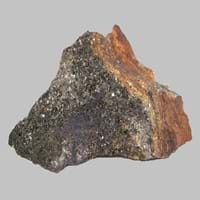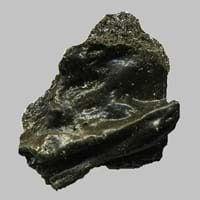Hornfels and Tachylite
Definition
Definition
Hornfels is a metamorphic rock formed by the contact between mudstone or other clay rich rock, and a hot igneous body, and represents a heat altered equivalent of the original rock
Tachylite is a vitreous form of basaltic volcanic glass. This glass is formed naturally by the rapid cooling of molten basalt
History
Origin
New Zealand
Iceland
Discoverer
Unknown
Unknown
Etymology
From German which means hornstone
From German Tachylite, from tachy- + Greek lutos soluble, melting
Class
Metamorphic Rocks
Igneous Rocks
Sub-Class
Durable Rock, Soft Rock
Durable Rock, Medium Hardness Rock
Family
Group
Not Applicable
Volcanic
Other Categories
Fine Grained Rock, Opaque Rock
Coarse Grained Rock, Fine Grained Rock, Medium Grained Rock, Opaque Rock
Texture
Texture
Granular, Platy
Vitreous
Color
Brown, Dark Greenish - Grey, Green, Reddish Brown
Black, Dark Brown
Maintenance
Less
More
Durability
Durable
Durable
Water Resistant
Yes
Yes
Scratch Resistant
No
No
Stain Resistant
No
No
Wind Resistant
No
Yes
Acid Resistant
No
Yes
Appearance
Dull
Glassy
Uses
Architecture
Interior Uses
Decorative Aggregates, Flooring, Homes, Interior Decoration
Decorative Aggregates, Interior Decoration
Exterior Uses
As Building Stone, As Facing Stone, Garden Decoration, Office Buildings, Paving Stone
As Building Stone, As Facing Stone, Garden Decoration, Paving Stone
Other Architectural Uses
Curbing
Curbing
Industry
Construction Industry
for Road Aggregate, Roadstone
Cutting Tool, Knives, Landscaping, Scrapers
Medical Industry
Not Yet Used
Not Yet Used
Antiquity Uses
Artifacts, Monuments
Artifacts
Other Uses
Commercial Uses
Cemetery Markers, Commemorative Tablets, Creating Artwork
Cemetery Markers, Creating Artwork
Types
Types
Biotite hornfels
Not Available
Features
Smooth to touch
Available in Lots of Colors and Patterns, Clasts are smooth to touch, NA
Archaeological Significance
Monuments
Used
Not Yet Used
Famous Monuments
Data Not Available
Not Applicable
Sculpture
Not Yet Used
Not Yet Used
Famous Sculptures
Not Applicable
Not Applicable
Pictographs
Used
Used
Petroglyphs
Used
Used
Figurines
Not Yet Used
Not Yet Used
Fossils
Absent
Absent
Formation
Formation
Due to change in environmental conditions, rocks are heated and pressurized deep inside the Earth's surface. Hornfels is formed from the extreme heat caused by magma or by the intense collisions and friction of tectonic plates.
Tachylite is a fine-grained, hard rock which is a type of metasomatite, essentially altered basalt. It forms with or without crystallization, either below the surface as intrusive rocks or on the surface as extrusive rocks.
Composition
Mineral Content
Andalusite
Feldspar, Olivine
Compound Content
Fe, Mg
Fe, Mg
Transformation
Metamorphism
No
Yes
Types of Metamorphism
Not Applicable
Burial Metamorphism, Cataclastic Metamorphism, Contact Metamorphism, Hydrothermal Metamorphism, Impact Metamorphism, Regional Metamorphism
Weathering
Yes
Yes
Types of Weathering
Biological Weathering
Biological Weathering, Chemical Weathering, Mechanical Weathering
Erosion
Yes
Yes
Types of Erosion
Chemical Erosion, Glacier Erosion, Sea Erosion, Water Erosion, Wind Erosion
Chemical Erosion, Sea Erosion, Water Erosion, Wind Erosion
Properties
Physical Properties
Hardness
2-3
5.5
Grain Size
Fine Grained
Medium to Fine Coarse Grained
Fracture
Conchoidal
Conchoidal
Streak
Unknown
Vermilion
Porosity
Highly Porous
Less Porous
Luster
Shiny
Resinous
Compressive Strength
5.80 N/mm2
31
206.00 N/mm2
8
Cleavage
Perfect
Not Available
Toughness
Not Yet Found
Not Available
Specific Gravity
3.4-3.9
2.4
Transparency
Opaque
Opaque
Density
0.25-0.30 g/cm3
3.058 g/cm3
Thermal Properties
Specific Heat Capacity
0.84 kJ/Kg K
15
0.56 kJ/Kg K
22
Resistance
Heat Resistant, Impact Resistant, Pressure Resistant
Heat Resistant, Impact Resistant, Wear Resistant
Reserves
Deposits in Eastern Continents
Asia
Bangladesh, Bhutan, China, India, North Korea, Qatar, Russia, Saudi Arabia, South Korea, Thailand
Cambodia, Russia, South Korea
Africa
Cameroon, East Africa, Tanzania, Western Africa
East Africa
Europe
United Kingdom
England, Germany, Hungary, Iceland, Scotland, Sweden
Others
Not Yet Found
Hawaii Islands
Deposits in Western Continents
North America
Canada, USA
USA
South America
Bolivia, Brazil, Colombia, Ecuador
Not Yet Found
Deposits in Oceania Continent
Australia
New South Wales, New Zealand, Queensland, Western Australia
Victoria
All about Hornfels and Tachylite Properties
Know all about Hornfels and Tachylite properties here. All properties of rocks are important as they define the type of rock and its application. Hornfels belongs to Metamorphic Rocks while Tachylite belongs to Igneous Rocks.Texture of Hornfels is Granular, Platy whereas that of Tachylite is Vitreous. Hornfels appears Dull and Tachylite appears Glassy. The luster of Hornfels is shiny while that of Tachylite is resinous. Hornfels is available in brown, dark greenish - grey, green, reddish brown colors whereas Tachylite is available in black, dark brown colors. The commercial uses of Hornfels and Tachylite are cemetery markers, commemorative tablets, creating artwork.
|
||
|
||
|










